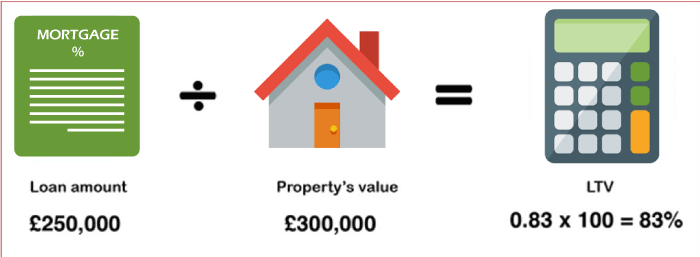Loan-to-Value (LTV) Ratio: What It Is, How To Calculate, ExampleThe loan-to-value (LTV) ratio is often employed in mortgage lending to determine the amount of down payment needed and whether a lender will offer loans to a borrower. Prior to giving a mortgage, financial firms and other lenders use the LTV ratio as an assessment of the risk associated with the financing. LTV measures how much of an asset's value a lender is willing to finance for the loan. High LTV loan assessments are typically seen as higher-risk loans. If the mortgage is approved at a high LTV, the rate of interest on the loan will be higher. Typically, a percentage approach is used to express LTV. 
The majority of lenders offer 'mortgages and home equity borrowers' the lowest rate of interest possible that they can receive when the LTV ratio is less than or equal to 80%. Borrowers with greater LTVs have to pay higher mortgage rates. The borrower may also be required to purchase mortgage insurance if the loan has a high LTV ratio to lower the risk to the lender. Private mortgage insurance (PMI) is the name for this coverage. Understanding the working concept of LTV RatioLTV ratio calculation is a crucial step in the mortgage underwriting process. It can be applied to the process of purchasing a home, refinancing an existing mortgage into a new loan, or taking out a loan against the equity built up in a property. Lenders consider the LTV ratio when assessing a mortgage application to evaluate the amount of risk they are willing to take on. When borrowers request a loan in an amount equal to or near the assessed value (and consequently has a higher LTV ratio), lenders assume there is a higher risk of default. This is because there isn't much equity in the property. Therefore, in the case of a foreclosure, the lender may struggle to sell the home for a price that will cover the outstanding debt and still allow for a profit. Down payments, sales prices, and a property's appraised worth are the key variables that affect LTV ratios. The LTV ratio is lowest when there are larger down payments and lower sales prices. Calculation of LTV RatioOne can calculate the LTV ratio easily by putting the required values in its formula. The formula for calculating LTV is defined below:
LTV Ratio = Mortgage Amount / Appraised Property Value
By dividing the loan amount by the percentage of the property's appraised value, one can determine the LTV ratio. For instance, suppose someone wants to make a $20,000 down payment to purchase a home valued at $100,000. In this case, he/she will have to borrow $80,000. Due to this, the LTV ratio is 80% (80,000/100,000). Likewise, if the loan amount is 250,000 and the property's value is 300,000, the calculated LTV will be 83%. 
How do lenders utilize LTV?An LTV ratio is just one of the criteria used to determine if a borrower qualifies for a mortgage, home equity loan, or line of credit. Additionally, it can also have a significant impact on the interest rate a borrower gets. Most lenders will give the lowest interest rate when an applicant's LTV ratio is below or equal to 80%. Although the interest rate on loans could go up when the LTV ratio rises, borrowers with a greater LTV ratio are still eligible to be authorized for a mortgage. For example, a borrower with a 95% LTV ratio can also be granted mortgage approval. However, they may be charged an interest rate which is a percentage point higher than the rate charged to a borrower with a 75% LTV ratio. A borrower can be obliged to acquire private mortgage insurance if the LTV ratio exceeds 80%. The annual increase in the loan's total amount due as a result of this can range from 0.5% to 1%. For instance, a 1% PMI on a loan for $200,000 would increase annual payments by an extra $2,000 per year. PMI payments are necessary up until the LTV ratio reaches 80% or less. As one pays off the loan and as the value of the property rises over time, the LTV ratio will go down. The likelihood that a loan will be authorized and the interest rate will be reduced increases with decreasing LTV ratios. Additionally, it's less likely that one will have to buy PMI as a borrower. Although it is not required, almost all lenders follow the practice of requiring an 80% LTV ratio for homeowners to eliminate the additional cost of PMI. For borrowers with a high income, little debt, or a sizable investment portfolio, exceptions to this rule are also occasionally permitted. LTV vs Combined LTVThe combined loan-to-value (CLTV) ratio compares the worth of a property to all secured loans on it. In contrast, the loan-to-value (LTV) ratio examines the effect of a single mortgage loan when buying a property. CLTV covers any secondary mortgages, loans against home equity or credit lines, or any liens in addition to the principal mortgage that is only utilized mechanism in LTV. When a potential home buyer uses multiple loans, such as two or more mortgages or a loan with an additional home equity loan or credit line, lenders utilize the CLTV ratio to assess their risk of default. Lenders are typically more focused on providing loans to borrowers with strong credit scores and CLTV ratios of 80% and higher. Since CLTV is a more comprehensive metric, primary lenders are frequently more generous with their requirements. Let's look at the difference a little more closely. The LTV ratio solely takes into account a home's primary mortgage debt. LTV is equal to 50% if the principal mortgage balance is $100,000 and the home's worth is $200,000. Consider the scenario if it also has a $20,000 HELOC (home equity loan or line of credit) and a $ 30,000-second mortgage. Now, the total loan to value is ($100,000 + $20,000 + $30,000 / $200,000) = 75%, which is a significantly higher ratio. This approach is an instance of CLTV. It's important to consider these two approaches, especially if the mortgage defaults and goes into foreclosure. Limitations/Disadvantages of LTV RatioThe biggest disadvantage of an LTV's approach is that it only includes the principal mortgage that a borrower owes and excludes additional debts of the homeowner, like a second mortgage or home equity loan, from its calculations. As a result, CLTV is a more comprehensive indicator that determines a borrower's ability to repay a mortgage. |
 For Videos Join Our Youtube Channel: Join Now
For Videos Join Our Youtube Channel: Join Now
Feedback
- Send your Feedback to [email protected]
Help Others, Please Share









